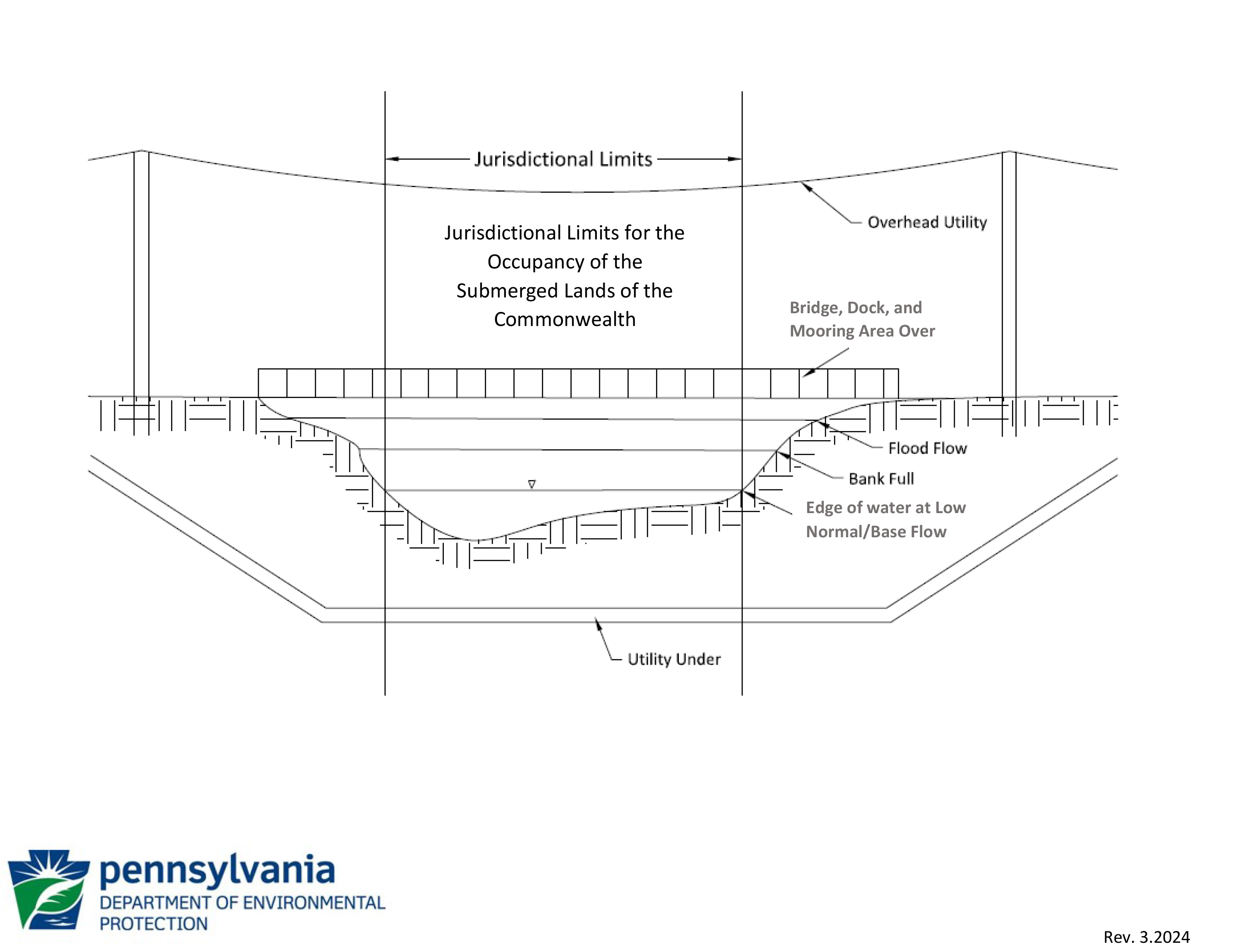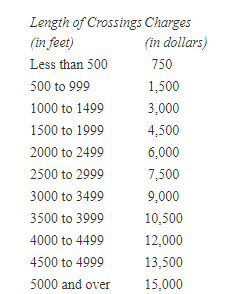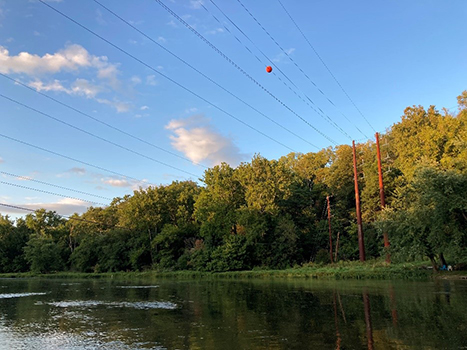Submerged Lands License Agreement
A Submerged Lands License Agreement (SLLA) is required for certain General Permits (GP) and Joint Permit Applications (JPA),
in accordance with Chapter 105 § 105. 31-35 and the Dam Safety and Encroachments Act, where the proposed facilities area is located on, over, in or under a stream, creek, or lake that has been legally determined to be the Navigable Waters of the Commonwealth. A Submerged Lands License Agreement is only necessary for facilities such as, but not limited to, docks, aerial wires, bridges, inlets, and pipelines that are located on the Navigable Waters of the Commonwealth.

Chapter 105 SLLA Regulatory Authority
Navigable Waters of the Commonwealth
It is important to begin with an examination of the Navigable Waters of the Commonwealth. This is because a Submerged Lands License Agreement is only necessary for facilities such as, but not limited to, docks, aerial wires, bridges, inlets, and pipelines that are located on, over, in or under a stream, creek or lake that has been legally determined to be Navigable Waters.
As the term “Navigable” would suggest, the waterway or lake should be of sufficient depth to sustain commercial traffic. Opinions of this have varied over the years (since the 1700’s) and a number of legal court cases have been centered around this very subject. At this point in time a waterway or lake is only considered to be Navigable Waters of the Commonwealth if it has been legally determined so in a court case. A few decades ago, Pennsylvania pooled the results of all these court cases into two lists of streams of Pennsylvania that have been legally established lists of Navigable Waters of the Commonwealth. These lists are called:
- Public Highway Declaration Act,
- Stream Beds owned by the Commonwealth
In addition, the Federal Government, through the Army Corps of Engineers, has added a few rivers that cross state lines and have a portion of their waterway in PA. This list is called:
- Appendix II, Streams Declared Navigable by the U.S. Army Corps of Engineers
The Public Highway Declaration Act contains the results of many legal decisions made from the 1770’s to the late 1890’s. The decisions make reference to many mills, roads, streams and landowners who no longer exist and are often difficult to locate. It often takes a search of historical records to determine the location of mills or farms and takes a fairly open mind to the changes in names that may have taken place over time.
The Stream Beds owned by the Commonwealth list is a summary list of streams and creeks that was compiled based on numerous (not referenced) legal decisions. The streams and creeks on this list are considered to be Navigable Waters of the Commonwealth over their entire length in Pennsylvania. It should be noted that many of the rivers, have their mouths in Pennsylvania but their headwaters are in other states.
The Appendix II, Streams Declared Navigable by the U.S. Army Corps of Engineers list contains federally listed rivers that impact multiple states and fall under the jurisdiction of both Pennsylvania and the Army Corps of Engineers. There are four main rivers the Ohio River, the Monongahela River, the Allegheny River and the Delaware River and portions of their tributaries. The list contains both the main channel for each river as well as portions of many tributaries to these rivers. The upstream limits on the tributaries is listed as so many miles from their mouth.
All of these lists are contained in the following
DEP List of Streams Subject to the Submerged Lands License Program document.
Jurisdictional Limits

Jurisdictional Limits of Submerged Lands of the Commonwealth Diagram
Submerged Lands of the Commonwealth – Licenses and Annual Charges
Information on Submerged Lands License Agreements, the types and fees can be found in the regulations at 25 Pa. Code § 105.31 through 105.35.
View the Submerged Lands of the Commonwealth – Licenses and Annual Charges (§105.31-35).
Annual Charges for Commercial Use of Submerged Lands are as follows:
- For areas occupied by facilities, $150 per tenth of an acre.
- For barge fleeting and mooring area, $30 per tenth of an acre.
- Minimum annual charge, $750.
Annual Charges for a private recreational dock that is “owned and used solely by the owners of adjacent riparian property, unless the project is otherwise authorized by a general permit” (25 Pa. Code §105.35(a)(2)), with a facilities area that is greater than .1 acres has an annual charge of $250. Private recreational docks located on Submerged Lands with a facilities area that is less than .1 acres does not have an annual fee.
Annual Charges for public service line crossings are as follows:

Annual Charges are not imposed for the following:
- 1) An activity or structure constructed, owned or operated by a department, commission or agency of the Commonwealth of Federal government.
- 2) A project or activity constructed, or operated primarily for the benefit of a State building or a State institution.
- 3) A flood control project constructed, owned or operated by an agency of the Commonwealth, the Federal government or a municipality.
- 4) A project or activity constructed, owned or operated by a political subdivision of this Commonwealth which provides potable water supply, sewage disposal or other similar services necessary for public health and welfare, or in connection with a service for which no fees or charges other than general taxes are imposed.
- 5) A facility to provide access to the general public to water for recreational boating, fishing, hunting, swimming or other recreation where the access provided without charge or on a nonprofit basis.
- 6) A structure or facility constructed and operated exclusively to improve fish habitat, under a cooperative agreement with the Fish and Boat Commission.
- 7) A private recreational dock constructed under a general permit.
25 Pa.Code § 105.35
Under Chapter 105, SLLAs are required for structures placed on, over, or under Submerged Lands of this Commonwealth and can only be obtained when an applicant applies for a Chapter 105 Dam Permit or Water Obstruction and Encroachment Permit. The total area of submerged lands occupied may not exceed 25 acres as granted by the Pennsylvania Department of Environmental Protection (DEP). Occupation of submerged lands greater than 25 acres requires an authorization by the Pennsylvania General Assembly,
See 25 Pa. Code § 105.32(b).
SLLA Resources
Historic Genealogical Map of the Counties
DEP’s List of Streams Subject to the Submerged Lands License Program
DEP and County Conservation District Offices and Contact
Jurisdictional Limits of Submerged Lands of the Commonwealth Diagram
SLLA Facilities Area Sample Drawings (all)
SLLA Processing Timeline
Submerged Lands License Agreements (SLLA) are only required when a General Permit (GP) or Joint Permit Application (JPA) has a facilities area on the navigable waters on the Commonwealth. A reviewer from either the County Conservation District with Chapter 105 delegated duties or DEP Regional Office is assigned to process the GP or JPA. The reviewer will determine if the GP or JPA needs an SLLA and will send the appropriate information to the DEP’s Central Office (BWEW) for processing.
The processing timeline for an SLLA starts when the DEP’s Central Office receives the notification from the DEP Regional Office or County Conservation District. The following is a step-by-step timeline that shows what is done between receiving the notification to prepare an SLLA and returning the fully executed document to the client.
- 1) DEP Central Office receives notification from reviewing office of SLLA need.
Note: permit application review will continue concurrently with the SLLA process.
- 2) DEP Central office will ensure it received sufficient SLLA information, or will request SLLA information from the permit applicant/registrant.
- 3) At the DEP’s Central Office, the agreement will be drafted using one of the SLLA agreement templates that were previously approved by the Office of Attorney General.
- 4) The draft agreement is prepared using the information provided by the reviewer.
- 5) The draft agreement is reviewed prior to sending to the client for signature. (Steps 3 and 4 will take about 2-3 weeks to complete)
- 6) The client will receive a package in an email asking to review the draft agreement and sign. The package will include:
- a. the draft SLLA
- b. the SLLA signature page,
- c. Exhibit B Right to Know Law Contract Provisions, and
- d. Exhibit C Affidavit of Signature Authority.
- 7) The client will return the signed signature page, a completed exhibit C, a document evidencing delegation of contracting authority (to be attached to exhibit C and the agreement), and the first-year filing fee (if required).
Note: delays in providing this information may delay SLLA processing and permit issuance.
- 8) Once the items listed in No. 6 are returned, the agreement is sent to the Division Chief for review and signature, the Division Chief’s signature is witnessed, and the agreement is sent to DEP’s Chief Counsel.
- 9) DEP’s Chief Counsel will review the agreement for legality and sign.
- 10) The agreement is sent to the Governor’s office for the final signature.
- 11) The fully executed agreement is sent to the client and DEP reviewer. (It takes about 3-4 weeks from when the required documents are returned from the client to sending the fully executed agreement to the client.)
- 12) Once the executed SLLA is received, the permit may be issued or acknowledged.
Note: a Chapter 105 permit that requires an SLLA agreement is not valid until the agreement is fully executed.
The processing timeline for an SLLA starts when the DEP’s Central Office receives the notification from the DEP Regional Office or County Conservation District to start processing.
The applicant is responsible for returning the required documents back to the Central Office. The Central Office cannot proceed with gathering the required signatures until the client returns the required documents. Once the agreement is fully executed, we return it to the client the same day or following day.
FAQs
Accordion
Expand AllClick here for a more accessible version

- SLLAs can only be included as part of a Water Obstruction and Encroachment Permit. If you have a project located on a navigable stream, please
contact the appropriate reviewing office for more information on obtaining the appropriate permits.
- DEP calculates the fees for the facilities area based on the area that is in the water. DEP uses the normal low flow of a stream, from the edge of water to the edge of water to determine facilities area.
- See the facility area sample drawings.
- Please refer to the three lists: the Public Highway Declaration Act; Stream Beds Owned by the Commonwealth; and Appendix II, Streams Declared Navigable by the U.S. Army Corps of Engineers. The three lists show the streams that are designated as navigable in Pennsylvania.
- All SLLA requests go through the reviewer at the DEP Regional Office or County Conservation District.
- The reviewer will send to the DEP Central Office for execution. It takes the Central Office about 2-3 weeks to draft the SLLA and send to the client.
- Depending on how long it takes the client to respond can prolong the processing time.
- It takes about 3-4 weeks average to obtain all the necessary signatures.
- When the SLLA is fully executed, the reviewer can issue the GP or JPA.